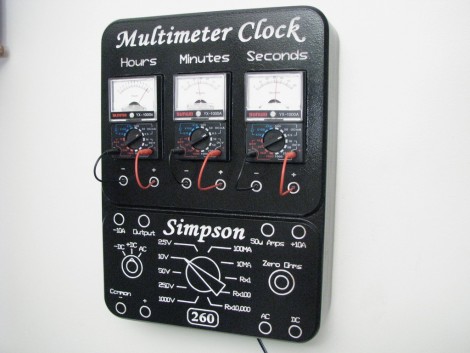
[Alan Parekh] built this clock to look like a Multimeter using analog multimeters for the three displays. A PIC does the timekeeping and feeds a specific amperage to the three displays which show hours, minutes, and seconds.
We’ve seen clocks that use analog meters before. [Alan] took the concept to the next level, replacing the graduated markings behind each needle to correspond to the correct display. He’s also included precise calibration so that each meter is as accurate as possible. After watching his video we’re convinced this is a refined product ready for a wide market, at least for those who appreciate the geek factor of the display.
















would be a lot better if it didn’t say “multimeter clock” and let you figure out hours, minutes, and seconds for yourself, this just cheapens it a bit.
I’d Buy one
First.
Wouldn’t have a voltage control of the multimeters drained less current on the battery ?
It’s not battery-powered.
Ok I leave !
:p
Very, very well done.
I bet this guy gets all the hot chicks!
I’m proud to be a nerd/geek but this is just embarrassing.
He should add a fourth, inverted meter near the bottom of the clock to act as a virtual pendulum.
wonder how difficult it would be to add atomic clock sync to this.
Waaaaay too cheesy.
Remove the lower part, it looks very lame, and remove the “multimeter clock” text, it looks cheap.
Without those things this would be some serious kicka$$, worthy of having it’s own spotlight.
But as it is they just completely ruin it, IMO.
ugly and kinda useless. Sorry.
Nicely done. My personal aesthetics would have been to use to have only the meters visible, not the entire meter. Looks looks there a possibility of moving the controls to front with out detracting from the Simpson facsimile. Use the range switch to replace the jumpers. hide the push switches behind the banana jacks.
@Bjonnh analog meters measure current by default. Driving the meters directly by bypassing multimeters internal circuitry may use less power, but I can’t really tell by the photos and video, perhaps the range selection is such they use the minimum power possible. Appears that oit’s quite possibl e to use battery power, D cells would last while probably, but why?
@D_
Actually, analog meters measure both, assuming DC, as there is a fixed relationship between voltage and current, since the resistance will be consistent. It’s just more stable between meters if you reference the current than the voltage. (slightly different wires will slightly change the coil resistance, and manufacturering processes for anything aren’t perfect, so there will always be variances between different parts)
I saw this on neatorama or nerdapproved the other day and think it is a neat concept but the build could have been better over all. It seems like if you are going through all of that trouble and have all of that open space, then why no actual turnable selection knob? I dunno, just looks like some plastic extruded thing you’d see on the wall at NAPA from a manufacturer. Without the story provenance it is kinda fizzly in my eyes overall. Like Target clearance aisle. Maybe I am just having midday sugar lows lol.
Well, this may be the most useless clock I have ever seen, but it still makes me LOL, so I will give the creator one and a half of my left over internets.
sweet, cool clock. my girl friend bought a mutimeter casing exactly like this one for 5 bucks to make something out of. it has the needles and thats all. brainstorming on ideas for this casing. suggestions anyone?
I, myself, think it’s aesthetically unpleasant, but it’s a good hack. And it’s a clock that can actually be, you know, read by normal people without a Calculus degree.
The batteries are only there for timekeeping when outside power is unavailable. The meters aren’t ever driven from the batteries, as the PIC is programmed to go into low-power mode when this happens. This thing should last years on a few AA batteries, since they’re just used to keep time when the power is out.
The meters themselves are set to the lowest-current mode they have, 0.5mA full-scale.
All good things.
And I’d do it differently. In fact, I may:
Scrap the giant air-filled housing, and the control boxes themselves. I’m thinking simple panel-mount ammeters, or just recovering them from cheap-ish multimeters.
Switches instead of jumpers. I hate jumpers.
I don’t like the way the needles bounce on big changes (reset to 0 seconds, for instance). Slowing down the input to the meters (low-pass? bell curve? something) or adding (predictive?) feedback would do a lot to help that.
I don’t like the fact that it’s probably wildly inaccurate. I want a PPS input from a GPS clock, or maybe just a box running NTP. Or, at least: Use the AC line as a stable 60Hz reference, which is always almost exactly dead-on, just like electric clocks have done forever. (That it’d drift a bit in battery mode is OK.)
Everybody here is complaining because it lacks some hardcore feature.
I think the fact that you have to read time through multimeters is hardcore enough.
Nice hack.
He should have used REAL Simpson 260’s for the displays.
http://www.simpsonelectric.com
And while he’s going LARGE in the build, where’s the “carry handle”? Useful to drag the clock around in your (presumably) huge laboratory.
I wonder if those are jewel-bearing meters. In this application they ought to be for reliability reasons.